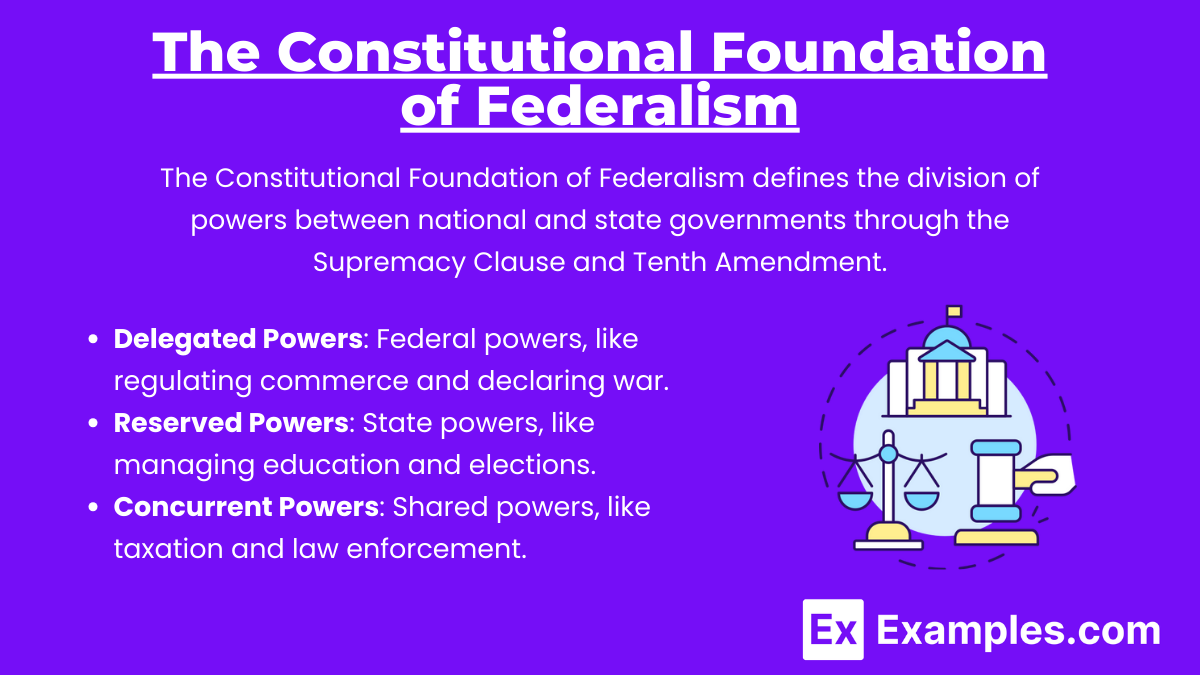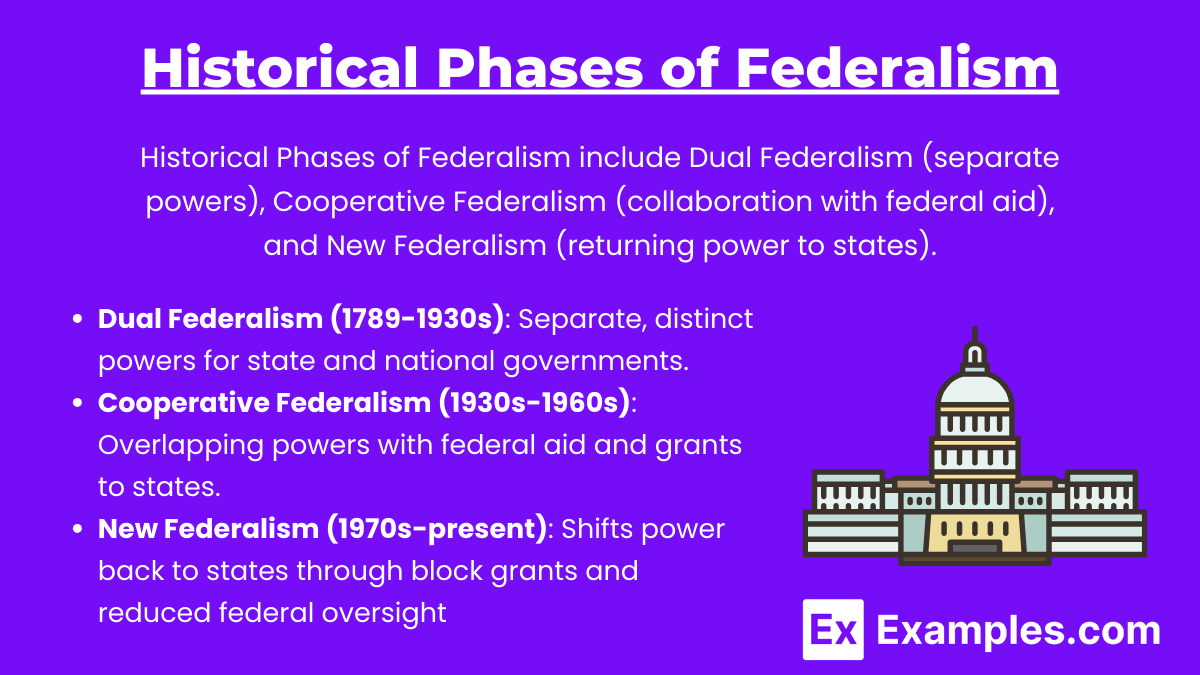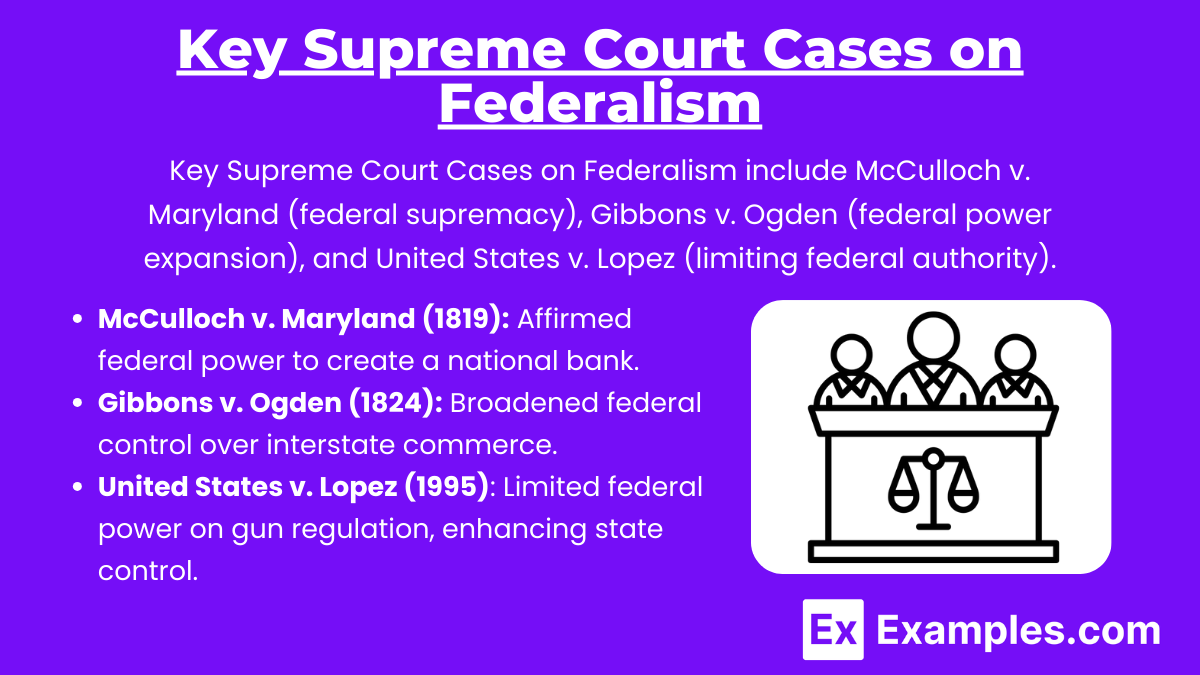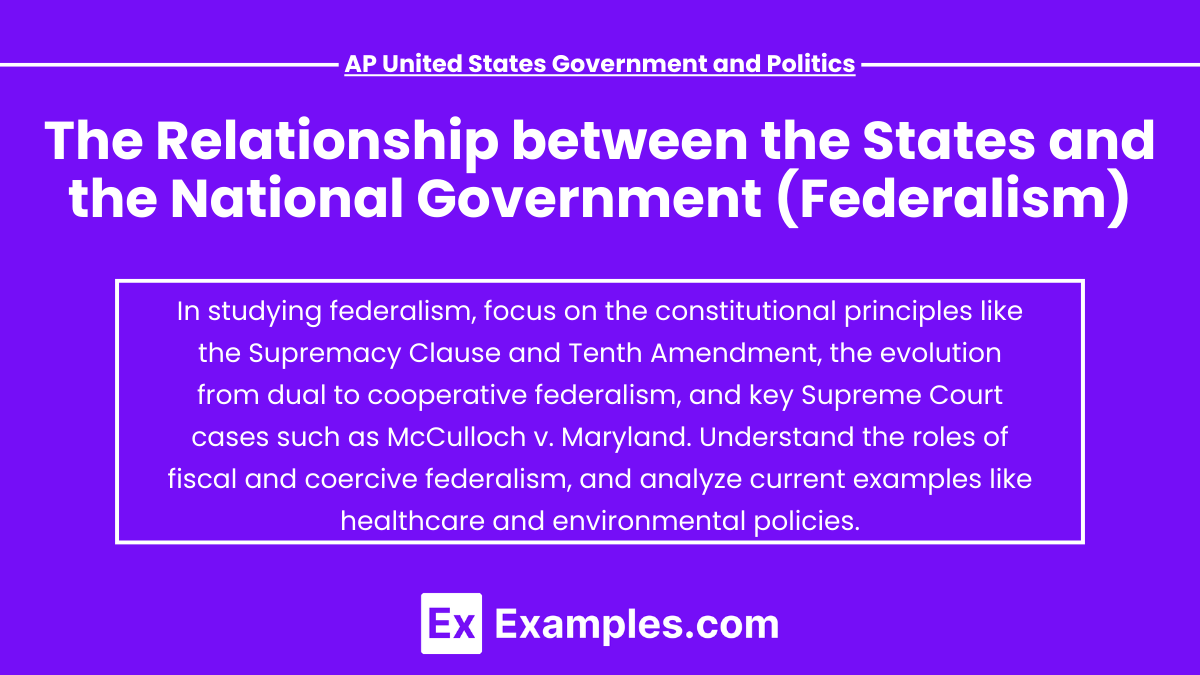Federalism in the United States refers to the constitutional division of power between the national government and state governments. This system allows both levels to govern independently in certain areas while sharing responsibilities in others. The Supremacy Clause establishes that federal law takes precedence over state law when conflicts arise, while the Tenth Amendment reserves powers not explicitly given to the federal government for the states. Over time, this relationship has shifted, from clear separations of power (dual federalism) to more cooperative approaches (cooperative federalism), influencing critical areas like healthcare, education, and environmental policies. Understanding federalism is essential for navigating U.S. governance.
Free AP United States Government and Politics Practice Test
Learning Objectives
For the topic "The relationship between the states and the national government (federalism)" in AP U.S. Government and Politics, you should learn the constitutional foundations of federalism, including the Supremacy Clause and Tenth Amendment. Understand how federalism has evolved through dual, cooperative, and fiscal federalism. Study key Supreme Court cases like McCulloch v. Maryland and United States v. Lopez. Finally, examine modern applications of federalism in areas such as healthcare, education, and environmental policy to understand the ongoing balance of power.
Federalism: The Relationship Between the States and National Government
Federalism in the United States refers to the division of powers between the national (federal) government and the state governments. This relationship has evolved since the founding of the nation, shaped by the U.S. Constitution, key Supreme Court cases, and political developments.
1. The Constitutional Foundation of Federalism

The U.S. Constitution sets the framework for federalism. The Supremacy Clause (Article VI) establishes that the Constitution, federal laws, and treaties are the supreme law of the land, taking precedence over state laws. However, the Tenth Amendment reserves powers not delegated to the federal government for the states or the people, maintaining a balance of authority.
Delegated Powers (also called enumerated powers): Powers explicitly granted to the federal government, like regulating interstate commerce, coining money, and declaring war (Article I, Section 8).
Reserved Powers: Powers reserved for the states, such as overseeing education and conducting elections.
Concurrent Powers: Powers shared by both the federal and state governments, including taxation and law enforcement.
2. Historical Phases of Federalism

Over time, federalism in the U.S. has shifted, with different models and interpretations of the state-national government relationship.
Dual Federalism (Layer Cake Federalism): This was prevalent from the founding until the New Deal era (1789-1930s). Under dual federalism, state and national governments functioned independently, with clear distinctions between their responsibilities.
Cooperative Federalism (Marble Cake Federalism): Emerging during the New Deal (1930s-1960s), this model saw an overlap in national and state powers, especially in response to economic crises. The federal government began providing grants and funding to states, often with specific conditions (e.g., infrastructure projects).
New Federalism (Devolution): Beginning in the 1970s and continuing into the modern era, New Federalism aims to return power to the states. Presidents like Richard Nixon and Ronald Reagan championed this approach through policies like block grants, which gave states more control over how federal funds were used.
3. Key Supreme Court Cases on Federalism

Several landmark Supreme Court cases have defined and redefined the balance of power between the states and the federal government:
McCulloch v. Maryland (1819): The Court ruled that the federal government had implied powers under the Necessary and Proper Clause to establish a national bank, and that states could not tax federal institutions (establishing national supremacy).
Gibbons v. Ogden (1824): This case expanded federal power by interpreting the Commerce Clause broadly, allowing the federal government to regulate interstate commerce.
United States v. Lopez (1995): The Court ruled that the federal government overstepped its bounds by using the Commerce Clause to regulate gun possession near schools, reinforcing state sovereignty in certain areas.
4. Types of Federalism

There are different forms of federalism that reflect how power is shared or divided between national and state governments:
Fiscal Federalism: Refers to the federal government’s use of financial incentives (grants, aid) to influence state policies. This can take the form of categorical grants (specific purposes) or block grants (more general purposes).
Coercive Federalism: Occurs when the federal government pressures states to comply with federal mandates, sometimes through unfunded mandates that require states to fulfill federal regulations without providing the necessary funding.
Examples
Example 1 : Medicaid Expansion under the Affordable Care Act (ACA)
The ACA, passed in 2010, required states to expand Medicaid to provide healthcare to more low-income individuals. However, the Supreme Court ruled in National Federation of Independent Business v. Sebelius (2012) that this mandate was unconstitutional, making Medicaid expansion optional for states. Some states chose to expand Medicaid with federal funding, while others opted out. This highlights the tension between federal incentives and states' autonomy in policy decisions related to healthcare.
Example 2 : Legalization of Marijuana
Marijuana remains illegal under federal law, classified as a Schedule I drug under the Controlled Substances Act. However, numerous states, such as California and Colorado, have legalized marijuana for medicinal or recreational use. This creates a conflict between federal law and state policies. In practice, the federal government has largely refrained from enforcing federal marijuana laws in states where it is legal, but the relationship is a prominent example of federalism in action, where states' rights challenge federal authority.
Example 3 : Environmental Regulations and the Clean Air Act
The Clean Air Act empowers the federal Environmental Protection Agency (EPA) to set national standards for air quality, but states are responsible for implementing and enforcing these standards. States can also choose to adopt more stringent environmental regulations, as California has done with its vehicle emissions standards. This arrangement showcases cooperative federalism, where both state and federal governments play roles in enforcing environmental laws, sometimes resulting in conflicts when states pursue stricter regulations than the federal government.
Example 4 : No Child Left Behind Act (2001)
The No Child Left Behind Act (NCLB) was a federal law that sought to improve educational outcomes by holding states accountable for student achievement. Under the law, states were required to meet specific benchmarks in student testing and school performance, or face federal sanctions. While education is traditionally a state responsibility, the NCLB Act reflected the federal government's growing role in shaping education policy. The act sparked debates over federal overreach in education, leading to its replacement by the Every Student Succeeds Act (2015), which returned more control to the states.
Example 5 : Disaster Response and Federalism: Hurricane Katrina
The federal government, through the Federal Emergency Management Agency (FEMA), plays a crucial role in disaster response, but state and local governments are the first responders. After Hurricane Katrina devastated parts of Louisiana and Mississippi in 2005, the disaster response exposed significant coordination failures between federal, state, and local governments. The federal government was criticized for its slow response, while state and local officials struggled with managing relief efforts. The event illustrated the challenges of federalism in emergency management, where cooperation between different levels of government is essential yet sometimes fraught with difficulties.
Multiple Choice Questions
Question 1
Which of the following Supreme Court cases established the principle that the federal government has implied powers beyond those explicitly listed in the Constitution?
A) United States v. Lopez
B) Gibbons v. Ogden
C) McCulloch v. Maryland
D) Marbury v. Madison
Answer: C) McCulloch v. Maryland
Explanation:
In McCulloch v. Maryland (1819), the Supreme Court ruled that the federal government has implied powers under the Necessary and Proper Clause of the Constitution. The case centered on whether Congress had the authority to create a national bank and whether a state (Maryland) could tax that bank. The Court ruled that Congress had the authority to establish the bank, and that states could not tax federal institutions, establishing the principle of federal supremacy and the doctrine of implied powers. This case strengthened the national government's power in relation to the states.
Question 2
What type of federalism emerged during the New Deal era, characterized by cooperation between national and state governments, often with federal funding provided to states for specific programs?
A) Dual Federalism
B) Coercive Federalism
C) Fiscal Federalism
D) Cooperative Federalism
Answer: D) Cooperative Federalism
Explanation:
Cooperative Federalism emerged during the New Deal (1930s) as a response to the economic crisis of the Great Depression. Under this model, the federal and state governments worked together to address national problems. Federal funds were provided to states through grants to implement programs such as Social Security and infrastructure projects. This model contrasted with Dual Federalism, where the two levels of government operated independently.
Question 3
Which clause of the U.S. Constitution ensures that federal laws take precedence over conflicting state laws?
A) Commerce Clause
B) Supremacy Clause
C) Necessary and Proper Clause
D) Full Faith and Credit Clause
Answer: B) Supremacy Clause
Explanation:
The Supremacy Clause (Article VI of the Constitution) establishes that the Constitution, federal laws, and treaties are the "supreme law of the land." This means that when there is a conflict between federal and state laws, federal laws override state laws. The Supremacy Clause ensures that states cannot interfere with or contradict federal authority, reinforcing the power of the national government over state governments in certain areas.


